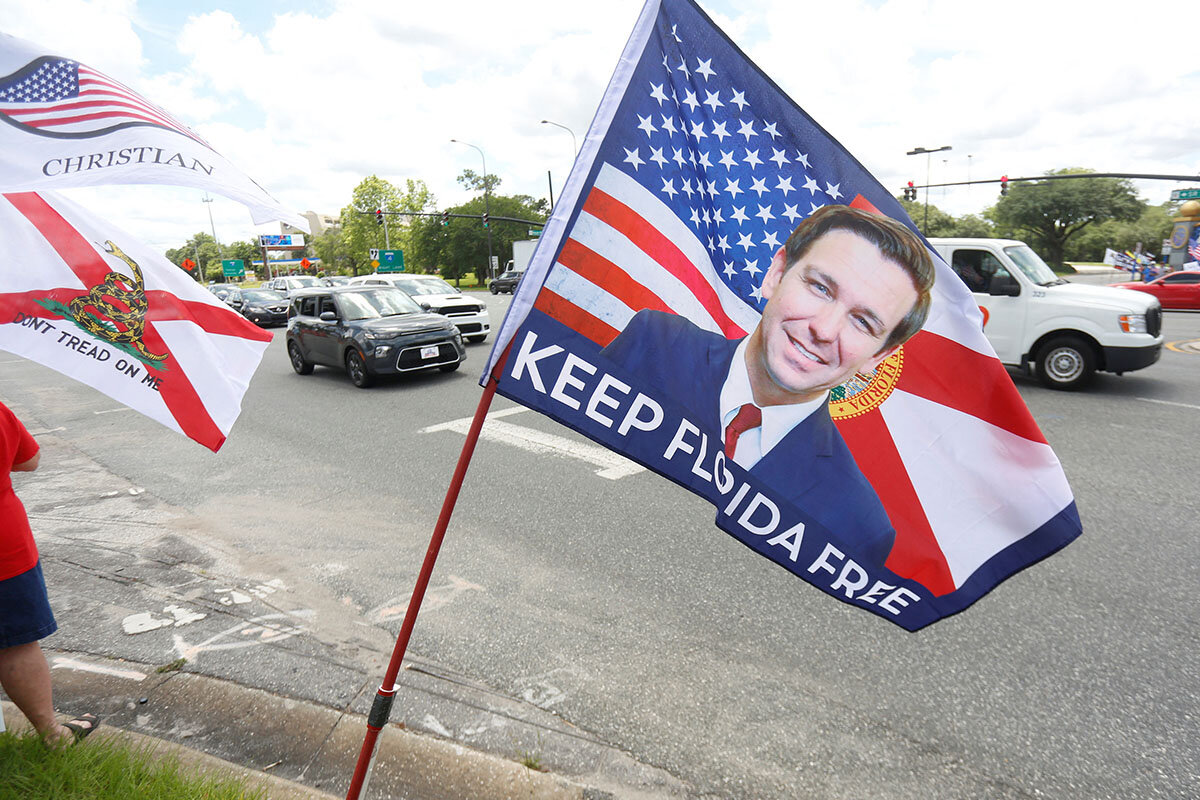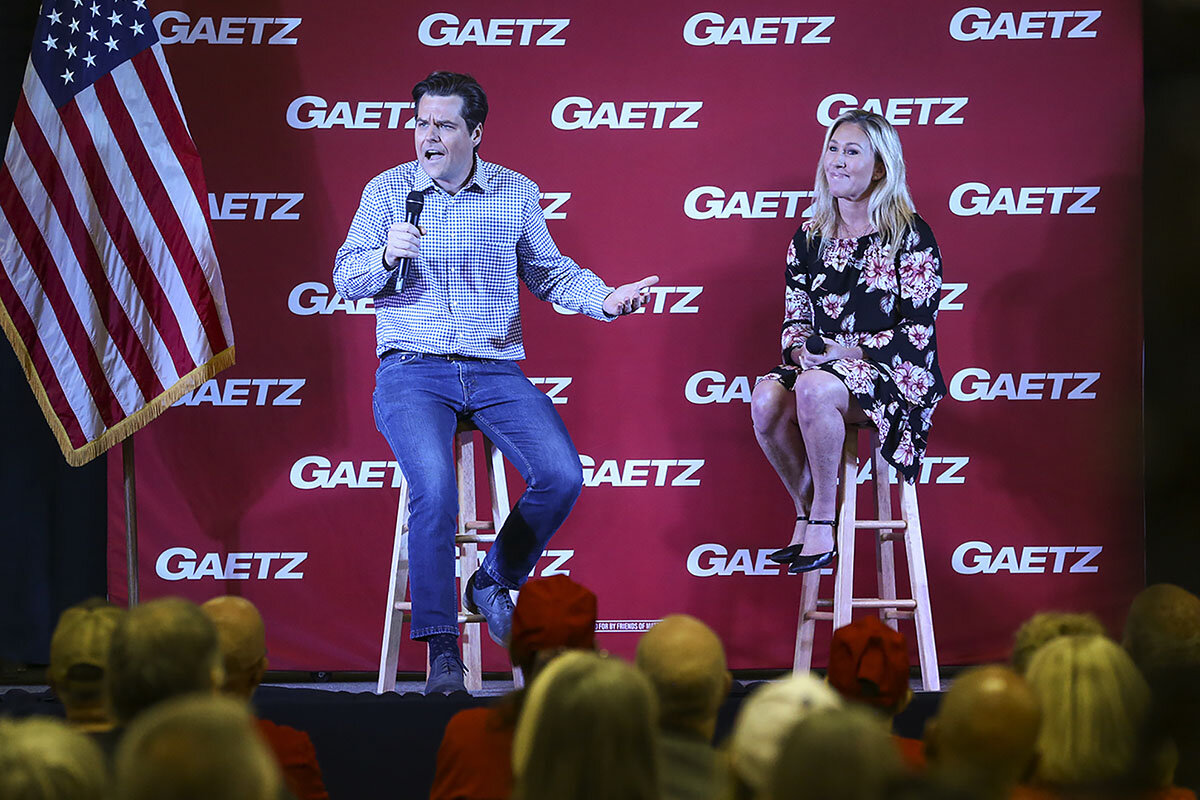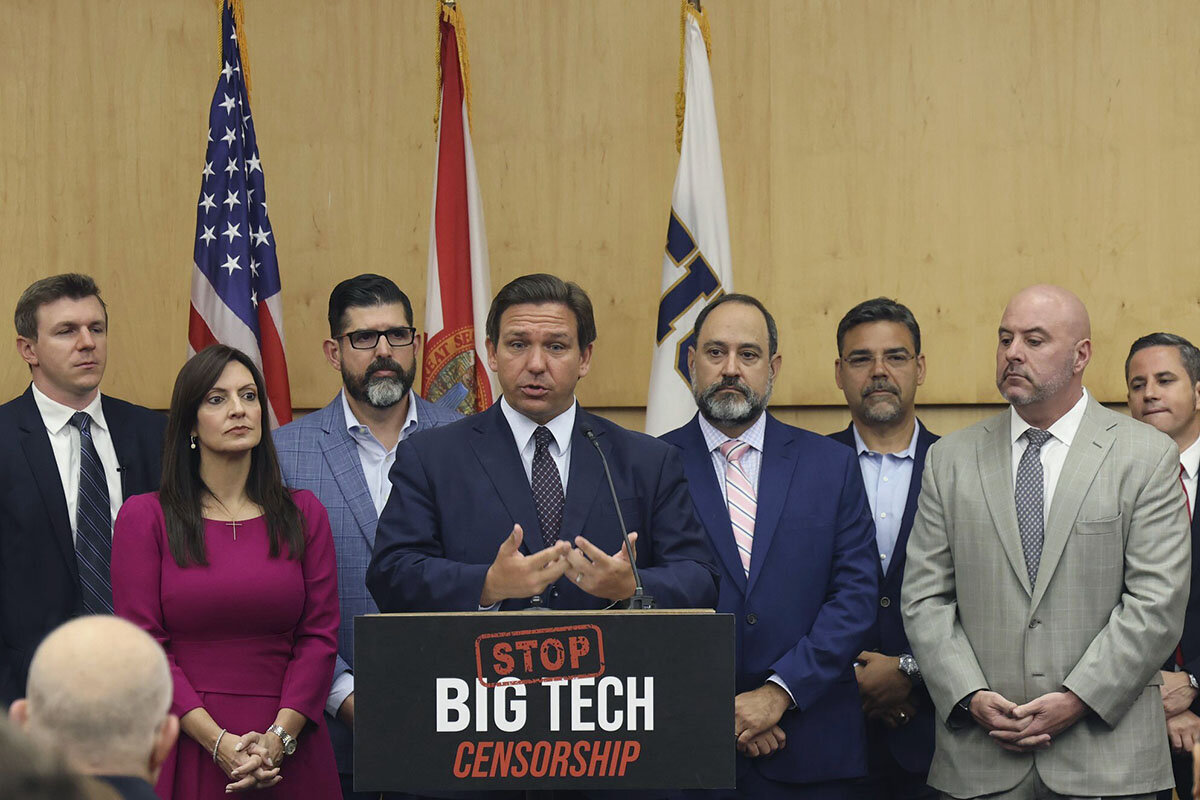‘Beacon of freedom’ or ‘Loudocracy’? How Florida became culture war central.
Loading...
| St. Petersburg, Fla.
Like many Floridians, Anna Paulina Luna is from somewhere else – in her case, California. The Air Force vet and sometime swimsuit model turned politician used to be, in her words, an “avid” Obama supporter.
But now she’s a staunch, vocal conservative. So conservative, in fact, that she’s been endorsed by former President Donald Trump for her run at a congressional seat in the Tampa Bay area. She appears to be the frontrunner to win the Republican primary and face off against a Democrat for a seat that could go to either party in the fall. Florida is “setting the standard for what conservatism is,” says Ms. Luna, who changed her last name from Mayerhofer to a Hispanic family name to broaden her appeal and reflect her roots.
“This is a place where I can speak up for what I believe in,” she adds. “People here aren’t afraid to be punished and canceled.”
Why We Wrote This
With a slew of new laws aimed squarely at the culture wars, an influx of conservatives, and Donald Trump in Mar-a-Lago, can Florida still be considered a swing state? Pinellas County is a study in how far the state’s transformation may go.
Is Anna Paulina Luna a symbol of where Florida politics is headed? Her personal transformations in many ways mirror what’s happened in the Sunshine State, as it’s moved in recent years from hotly contested national battleground to a possible model of modern Trumpist conservatism.
After all, former President Barack Obama won Florida twice. But following him, former President Trump won it twice, as well. Mr. Trump now lives here at Mar-a-Lago in Palm Beach, a Republican gathering spot and neo-Versailles.
Florida Gov. Ron DeSantis is both a Trump follower and possible Trump opponent, as he’s declined to say whether he’d face off against the former president for the 2024 GOP nomination. He’s pushed through a number of state bills that deal with hot button partisan issues, such as the recently enacted Parental Rights in Education, dubbed by critics the “don’t say gay” law, that bans school teaching of sexual topics deemed non-age-appropriate.
“A culture war edge”
Florida is “becoming redder all the time, and it has a very arch-conservative edge – a culture war edge,” says Orlando-based historian James Clark, author of “Hidden History of Florida.”
In some ways, Florida – the land of the hanging chads, the bits of paper that dangled from Florida ballots and were a centerpiece of the disputed 2000 presidential election – remains a tightly contested battleground state.
Political scientists call Florida voters a “rootless electorate” whose preferences can switch back and forth relatively quickly.
Yet as the nation’s third-most-populous state, its bare-knuckled rightward swing has been unmistakable, wobbling the nation’s political gyroscope. The best-known governor in the country may now be Mr. DeSantis, a Harvard and Yale grad who served as a judge advocate general at Guantánamo Bay.
Already facing an uphill climb nationally in this year’s mid-terms, Democrats are reacting in alarm to the prospect of a DeSantis-led Republican Party locking down political power in the state.
What some Democrats see as incipient authoritarianism, many Republicans see as a Governor DeSantis-led punch-back against liberal values that don’t represent how many Floridians live and think.
Experts say that what’s happening in Florida is an aspect of a political phenomenon that’s deeply American: an ever-shifting balance of power between the state and the individual. It’s a dynamic that’s been supercharged in recent years by a life-changing pandemic and national clashes over race, class, and values.
“Is Florida a swing state, a competitive state, still? Yes, based on the evidence,” says Aubrey Jewett, a political scientist at the University of Central Florida, in Orlando. “But may it be trending Republican and not competitive in the near future? That is possible.”
In recent years, Democrats have been steadily losing ground here. That’s only been accelerated by the political reaction to pandemic restrictions.
In just over a decade, Republicans have experienced a net gain over Democrats of 750,000 voter registrations. By this measure the GOP is now the largest party in the state. Once safely blue areas such as Miami-Dade County are now in play. In 2016, Hillary Clinton won Miami-Dade by 30 percentage points. By 2020, that margin had dwindled to a 7-point win for Joe Biden. In raw numbers, 300,000 county voters had swung to the right, many of them Hispanics deeply suspicious of leftist politics, says Matthew Isbell, a Democratic strategist.
“What do Democrats have left?”
The Republican narrative for Florida is that it is a “beacon of freedom,” in GOP state Sen. Joe Gruters’ words, that draws conservatives from around the country as residents.
That narrative contains both hyperbole and truth, says state Sen. Tina Polsky, a Democrat whose biggest concern is independent voters turning hard to the right.
“Republicans took this very slim margin of victory and decided that we are completely a red state,” says Ms. Polsky, who represents parts of Broward and Palm Beach counties. “There’s a lot of people who feel that way, but how many are there? Obviously a lot. And yeah they’re louder than us. That doesn’t mean there’s more of them.”
One changing dynamic, says Mr. Isbell, is that the traditional retiree flow from New England and New Jersey – more Democratic, heavily Jewish – has changed. In-migration to Florida is now full of people from more conservative corners of the Midwest, and other parts of the South.
At the same time, as Hispanics have swung hard into the Republican column, white working-class areas like Volusia County – which includes Daytona – and Pasco County have turned from mildly conservative to deep red.
In short, he says: Republicans now have the working class, Hispanic voters, and Republican retirees. They are also very strong in upper-income suburbs and strong with rural voters.
“So, the question is,” says Mr. Isbell, “what do Democrats have left?”
Central to the shift has been Governor DeSantis, a Trump acolyte whose single term can be divided into two acts, according to experts.
In Act I, Governor DeSantis showed a streak of pragmatic discipline that political analysts say often eluded Mr. Trump. He took on Big Sugar, and pushed through a massive $800 million Everglades rehabilitation program. A medical marijuana referendum was bogged down in the legislature until Mr. DeSantis strong-armed it forward.
Yes, Florida passed a bill that limits abortions after 15 weeks, and appears patently unconstitutional under its own state constitution, which explicitly guarantees a right to privacy, as well as Roe v. Wade, the 1973 ruling that established a federal right for women to choose. But the Supreme Court seems poised to limit or overturn Roe. Ninety-one percent of abortions take place within the first 13 weeks of pregnancy, according to Planned Parenthood.
In Act II, after getting positive reviews from many conservatives on his pushback against pandemic restrictions, the governor has signed or proposed a slew of bills that appear aimed more at making points in national culture wars. They include the “Stop WOKE Act,” which prohibits teaching that could make students feel they bear responsibility for historic wrongs and businesses from using diversity training that could have the same result, a “de-platforming” bill that would fine social media companies for kicking a politician off their platform (currently stalled by lawsuits), an “anti-riot” bill that stiffens penalties for some protest activity, and “don’t say gay,” that bans school teaching of sexual and gender topics deemed non-age-appropriate.
Governor DeSantis has even wrestled with Florida’s most famous corporation – Disney – after the firm pushed back on the “don’t say gay” law. On Tuesday, he called a special session to remove “special districts” enacted before 1968, targeting Walt Disney World’s Reedy Creek Improvement District. While the legislation has been largely panned nationally, in Florida it is nearly as popular among Democrats as Republicans.
“DeSantis is trying to take the Trump model within state government and Republicans have gone along with him on that,” says Mr. Isbell.
The governor is “a smarter version of Trump, which for Democrats like me is terrifying,” Mr. Isbell says.
In the process, he has become the most powerful governor in modern Florida history, says Mr. Clark, the historian.
This year the state legislature has even handed Governor DeSantis the authority to take the lead on redrawing the state’s 28 congressional districts, after he vetoed the GOP-controlled legislature’s own map in March. Mr. DeSantis has proposed a redistricting map that would give Republicans a 20-8 advantage and eliminate two districts now represented by Black Democrats.
“He is ideologically and preternaturally organized for power,” says Anthony Brunello, a political scientist at Eckerd College in St. Petersburg.
Pinellas County as case study
“We are in essence creating a state that is jam-packed with freedom and pushing back on liberal lunacy,” says Christian Ziegler, a Republican county commissioner in Sarasota County.
But there may be a darker side to the DeSantis agenda that exacerbates deep, historic divides in the U.S.
State Republicans may be taking advantage of the frustrations felt by many voters of a society painted by academics and the media as divided cleanly along racial lines, while ignoring the role of class and culture, says Nancy Isenberg, author of “White Trash,” a history of class in America.
But that, she says, can also be seen as a thinly-veiled nod to a Southern penchant for centralized power that preserves a white status quo.
“Think about all the hostility about no masks, no indoctrination in the schools, you can’t say gay, no woke, no CRT [critical race theory] – all of it comes from the 1950s. The Democrats are communists who are indoctrinating children, engaging in mind control, and creating a new generation of woke robots,” says Ms. Isenberg.
“It’s loudocracy, throwing out words, claiming they want free speech except for when it’s something they don’t want to hear,” Ms. Isenberg says.
Pinellas County is a study in how far the state’s transformation may go.
The sunny county seat of St. Petersburg was the home of the late U.S. Rep. Bill Cramer, a Republican who helped redefine the state party in the 1970s, laying the groundwork for its modern ascendancy.
But in a municipal election last year, St. Petersburg elected its first Black mayor, a Democratic Socialist city councilor – the state’s first – and for the first time had three Black members on the city council.
Rep. Charlie Crist, a Democrat who is challenging Gov. DeSantis, turned Florida’s 13th congressional district, which currently centers on St. Petersburg, blue in 2016. Mr. Trump won Pinellas by 2,000 votes in 2016; Joe Biden won it by 2,000 votes in 2020.
The county grows progressively redder as it moves north into the suburbs of Clearwater, New Port Richey, Tarpon Springs, and Safety Harbor. Further north, the transformation becomes complete. There, in working-class Citrus County, Mr. Obama won by a single point in 2012; Mr. Trump won it in 2016 by 20 points.
That puts the region on a sort of national dividing line, indicative if not definitive of changing political leanings.
“The biggest thing for the Republican Party to be cautious of is becoming too arrogant and comfortable,” says former St. Petersburg mayor Rick Kriseman, a Democrat. “They’ve been in power so long [at the legislature] that they are getting to the point that there’s no collaboration, no willingness to even listen to and consider opposing viewpoints.”
“That’s when you start getting bad policy that ultimately does have a fiscal and financial impact on the economy,” says Mr. Kriseman. “Then the public is going to start feeling it more and asking: What’s causing this? And it’s going to be easy for Democrats to say, ‘These guys are the ones in charge.’”
Ms. Luna is running for the congressional seat that Democrat Mr. Crist is giving up to run for governor.
When it comes to Florida’s future, she says does not share Mr. Kriseman’s worries.
The Tampa Bay area, she says, is becoming an exile community for conservative social media personalities like herself.
Though she was an enthusiastic Obama supporter, she now says she is one of a growing number of converts to the conservative cause in a red-tinged state. She insists she is more than an opportunistic transplant.
“We’re less congested than Los Angeles, there’s affordable housing – well, at least up until recently – gas prices are lower, and policies here make it a heck of a lot easier with me having my business out of Florida,” says Ms. Luna.









